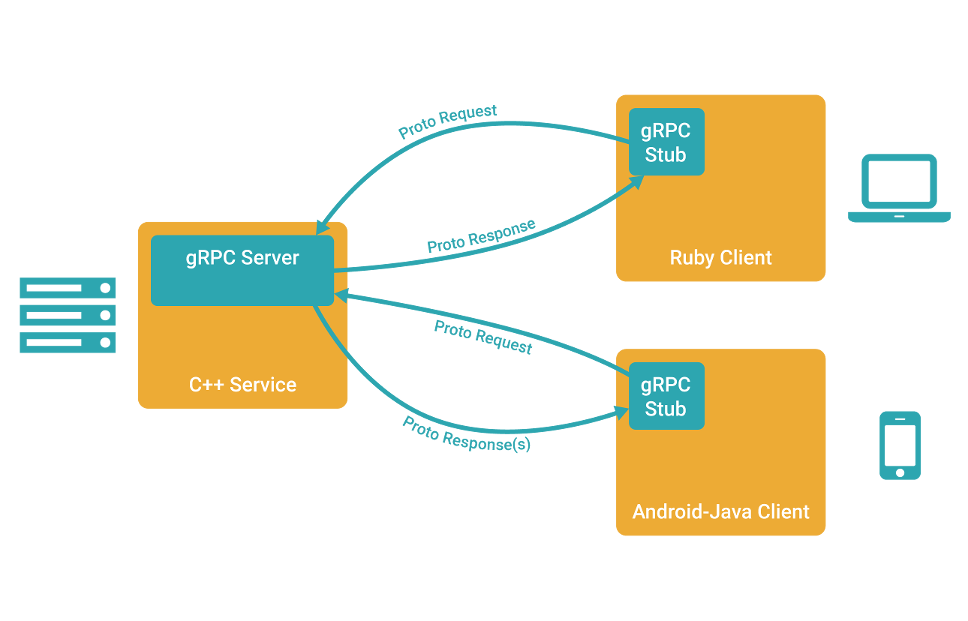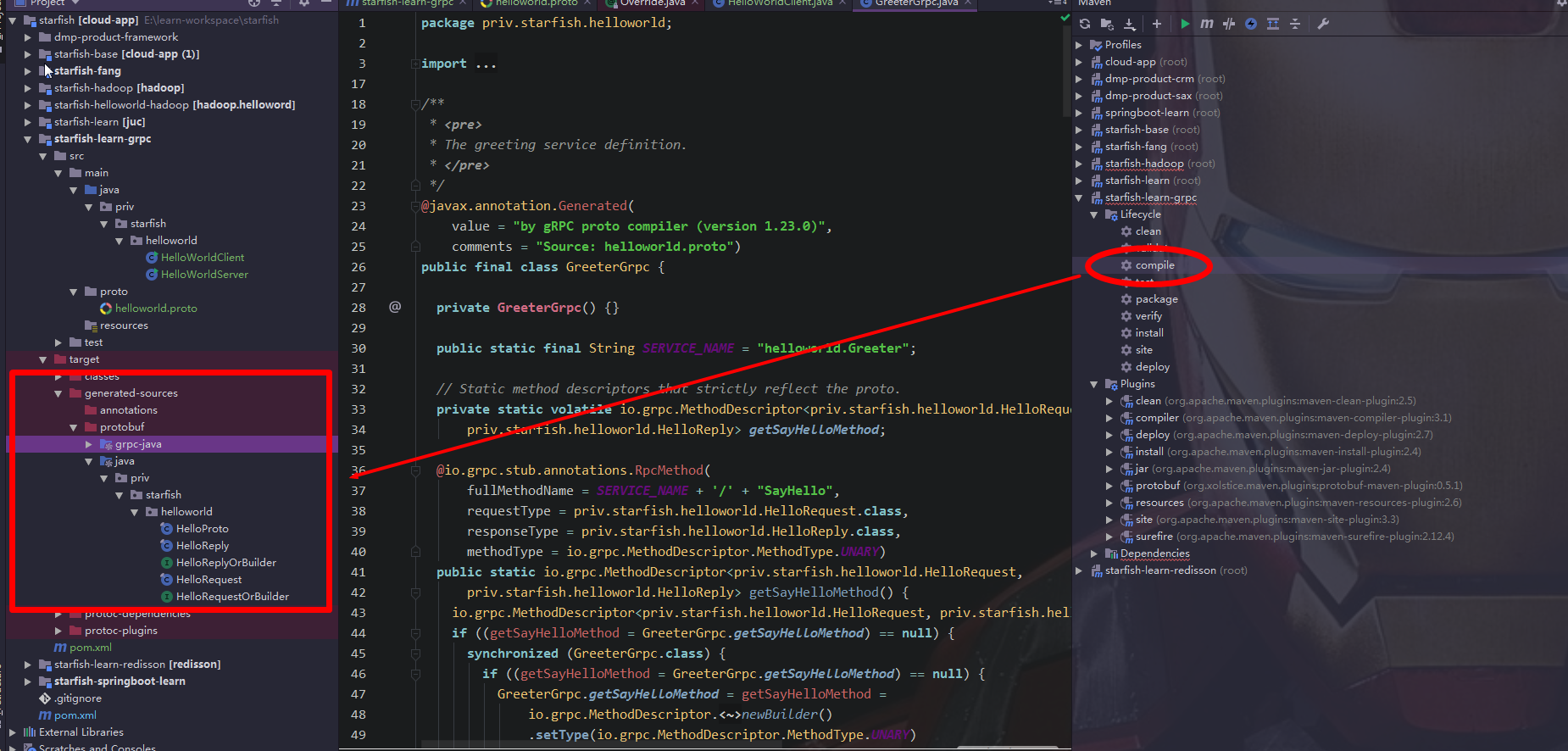gRPC是一个高性能,跨平台的开源RPC框架,它可以通过可插拔的负载平衡、跟踪、健康检查和身份验证支持,有效地连接数据中心内部和跨数据中心的服务,支持移动端、浏览器端等各种分布式的后端服务。
在 gRPC 里客户端应用可以像调用本地对象一样直接调用另一台不同的机器上服务端应用的方法,使得您能够更容易地创建分布式应用和服务。与许多 RPC 系统类似,gRPC 也是基于以下理念:定义一个服务,指定其能够被远程调用的方法(包含参数和返回类型)。在服务端实现这个接口,并运行一个 gRPC 服务器来处理客户端调用。在客户端拥有一个存根能够像服务端一样的方法。

-
通过Protocol Buffers, 定义服务的传输数据
-
支持多种语言和平台,可通过插件为您的服务自动生成的客户机和服务器存根
-
用单行安装运行时和开发环境,并使用该框架扩展到每秒数百万个rpc
-
基于http2传输 的双向流和完全集成的可插拔式身份验证
Hello gRPC
话不多说,先把项目跑起来~~ 嗖~嗖~~
一切从简,直接用IDEA的强大功能生成各种文件就可以了,懒得下载protoc 编译器。
1. IDEA安装Protobuf Support 插件
2. POM文件
<dependencies>
<dependency>
<groupId>com.google.protobuf</groupId>
<artifactId>protobuf-java</artifactId>
<version>3.9.0</version>
</dependency>
<dependency>
<groupId>io.grpc</groupId>
<artifactId>grpc-netty-shaded</artifactId>
<version>1.23.0</version>
</dependency>
<dependency>
<groupId>io.grpc</groupId>
<artifactId>grpc-protobuf</artifactId>
<version>1.23.0</version>
</dependency>
<dependency>
<groupId>io.grpc</groupId>
<artifactId>grpc-stub</artifactId>
<version>1.23.0</version>
</dependency>
<dependency>
<groupId>io.grpc</groupId>
<artifactId>grpc-core</artifactId>
<version>1.23.0</version>
</dependency>
</dependencies>
<!-- protobuf-maven-plugin插件,用于生成Stub代码库-->
<build>
<extensions>
<extension>
<groupId>kr.motd.maven</groupId>
<artifactId>os-maven-plugin</artifactId>
<version>1.5.0.Final</version>
</extension>
</extensions>
<plugins>
<plugin>
<groupId>org.xolstice.maven.plugins</groupId>
<artifactId>protobuf-maven-plugin</artifactId>
<version>0.5.1</version>
<configuration>
<protocArtifact>com.google.protobuf:protoc:3.9.0:exe:${os.detected.classifier}</protocArtifact>
<pluginId>grpc-java</pluginId>
<pluginArtifact>io.grpc:protoc-gen-grpc-java:1.23.0:exe:${os.detected.classifier}</pluginArtifact>
</configuration>
<executions>
<execution>
<goals>
<goal>compile</goal>
<goal>compile-custom</goal>
</goals>
</execution>
</executions>
</plugin>
<plugin>
<groupId>org.apache.maven.plugins</groupId>
<artifactId>maven-compiler-plugin</artifactId>
<configuration>
<source>6</source>
<target>6</target>
</configuration>
</plugin>
</plugins>
</build>
3. helloworld.proto文件
syntax = "proto3";
option java_multiple_files = true;
option java_package = "priv.starfish.helloworld";
option java_outer_classname = "HelloProto";
option objc_class_prefix = "HLW";
package helloworld;
// The greeting service definition.
service Greeter {
// Sends a greeting
rpc SayHello (HelloRequest) returns (HelloReply) {}
}
// The request message containing the user's name.
message HelloRequest {
string name = 1;
}
// The response message containing the greetings
message HelloReply {
string message = 1;
}
4. complie自己的maven项目

5. Server + Client
Ctrl +C ——> Ctrl +V 官网的demo: https://github.com/grpc/grpc-java/tree/master/examples/src/main/java/io/grpc/examples/helloworld
package priv.starfish.helloworld;
import io.grpc.Server;
import io.grpc.ServerBuilder;
import io.grpc.stub.StreamObserver;
import java.io.IOException;
import java.util.logging.Logger;
public class HelloWorldServer {
private static final Logger logger = Logger.getLogger(HelloWorldServer.class.getName());
private Server server;
private void start() throws IOException {
int port = 50051;
server = ServerBuilder.forPort(port)
.addService(new GreeterImpl())
.build()
.start();
logger.info("Server started, listening on " + port);
Runtime.getRuntime().addShutdownHook(new Thread() {
@Override
public void run() {
// Use stderr here since the logger may have been reset by its JVM shutdown hook.
System.err.println("*** shutting down gRPC server since JVM is shutting down");
HelloWorldServer.this.stop();
System.err.println("*** server shut down");
}
});
}
private void stop() {
if (server != null) {
server.shutdown();
}
}
/**
* Await termination on the main thread since the grpc library uses daemon threads.
*/
private void blockUntilShutdown() throws InterruptedException {
if (server != null) {
server.awaitTermination();
}
}
/**
* Main launches the server from the command line.
*/
public static void main(String[] args) throws IOException, InterruptedException {
final HelloWorldServer server = new HelloWorldServer();
server.start();
server.blockUntilShutdown();
}
static class GreeterImpl extends GreeterGrpc.GreeterImplBase {
@Override
public void sayHello(HelloRequest req, StreamObserver<HelloReply> responseObserver) {
HelloReply reply = HelloReply.newBuilder().setMessage("Hello,my " + req.getName()).build();
responseObserver.onNext(reply);
responseObserver.onCompleted();
}
}
}
package priv.starfish.helloworld;
import io.grpc.ManagedChannel;
import io.grpc.ManagedChannelBuilder;
import io.grpc.StatusRuntimeException;
import java.util.concurrent.TimeUnit;
import java.util.logging.Level;
import java.util.logging.Logger;
/**
* A simple client that requests a greeting from the {@link HelloWorldServer}.
*/
public class HelloWorldClient {
private static final Logger logger = Logger.getLogger(HelloWorldClient.class.getName());
private final ManagedChannel channel;
private final GreeterGrpc.GreeterBlockingStub blockingStub;
/** Construct client connecting to HelloWorld server at {@code host:port}. */
public HelloWorldClient(String host, int port) {
this(ManagedChannelBuilder.forAddress(host, port)
// Channels are secure by default (via SSL/TLS). For the example we disable TLS to avoid
// needing certificates.
.usePlaintext()
.build());
}
/** Construct client for accessing HelloWorld server using the existing channel. */
HelloWorldClient(ManagedChannel channel) {
this.channel = channel;
blockingStub = GreeterGrpc.newBlockingStub(channel);
}
public void shutdown() throws InterruptedException {
channel.shutdown().awaitTermination(5, TimeUnit.SECONDS);
}
/** Say hello to server. */
public void greet(String name) {
logger.warning("Will try to greet " + name + " ...");
HelloRequest request = HelloRequest.newBuilder().setName(name).build();
HelloReply response;
try {
response = blockingStub.sayHello(request);
} catch (StatusRuntimeException e) {
logger.log(Level.WARNING, "RPC failed: {0}", e.getStatus());
return;
}
logger.info("Greeting: " + response.getMessage());
}
/**
* Greet server. If provided, the first element of {@code args} is the name to use in the
* greeting.
*/
public static void main(String[] args) throws Exception {
HelloWorldClient client = new HelloWorldClient("localhost", 50051);
try {
/* Access a service running on the local machine on port 50051 */
String user = "world";
if (args.length > 0) {
user = args[0]; /* Use the arg as the name to greet if provided */
}
client.greet(user);
} finally {
client.shutdown();
}
}
}
6. 分别启动server和client

最后
以上就是平常微笑最近收集整理的关于gRPC-Hello World的全部内容,更多相关gRPC-Hello内容请搜索靠谱客的其他文章。
本图文内容来源于网友提供,作为学习参考使用,或来自网络收集整理,版权属于原作者所有。








发表评论 取消回复